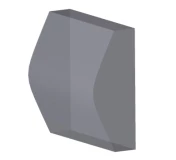Description
Acylindrical lenses are the cylindrical counterpart to an aspheric lens and designed to combine the aberration-reducing benefits of an aspheric surface with the one-dimensional focusing of a standard cylindrical lens.
Positive cylindrical lenses are ideal for uses requiring magnification in one dimension. While spherical lenses work symmetrically in two dimensions on an incident ray, cylindrical lenses act in the same manner but only in one dimension. A typical application is to use a pair of cylindrical lenses to provide anamorphic shaping of a beam. A pair of positive cylindrical lenses can be used to collimate and circularize the output of a laser diode. Another application would be to use a single lens to focus a diverging beam onto a detector array.
Photonchina’s cylindrical lenses are slightly deviated from a true cylinder in a way that minimizes the introduction of aberrations, which result in a wavefront error of 500nm.Our lenses are fabricated using S-LAH64 optical glass, that is a low dispersion glass with high index of refraction in order to limit chromatic aberration.
Acylindrical Lens
Specifications
| Substrate: | N-BK7, Fused Silica (FS), UV Grade Fused Silica (UVFS), CaF2, ZnSe, Ge, N-SF5, H-LAK54, H-ZLaF52, H-ZLaF5B, S-NPH1, D-LaK6, Not Specified, Other |
|---|---|
| Diameter: | 3 – 500 mm |
| Wavelength Range: | 450 – 1550 nm |
| Wavefront Error: | 500 nm |
| Numerical Apertures: | 0.45-0.50 |
| Optical Coating A: | 350 - 700 nm |
| Optical Coating B: | 650 - 1050 nm |
| Design Wavelength: | 780 nm |
| RMS Wavefront Error: | < 0.5 µm |
| Surface Quality: | 60-40 or better |
| Lens Material: | S-LAH64 |
| Index Of Refraction At 780 Nm: | 1.777 |
| Abbe Number: | 47.3 |
| Focal Length Tolerance: | <1% |
| Average Reflectance: | <0.5% |
| Central Peak Reflectance: | <0.25% |
| Angles Of Incidence: | 0° to 30° (0.5 NA) |
Features
- Aberration-Reducing Acylindrical Surface: These cylindrical lenses feature an acylindrical surface that combines the benefits of aspheric lenses with one-dimensional focusing, minimizing aberrations.
- Numerical Apertures: Available in a range of 0.45 to 0.50, suitable for various optical applications.
- High-Quality Fabrication: Made from S-LAH64 optical glass, known for its low dispersion and high index of refraction, limiting chromatic aberration.
- Design Wavelength: Optimized for 780 nm.
- RMS Wavefront Error: Less than 0.5 µm, ensuring high precision.
- Surface Quality: 60-40 or better, providing excellent optical performance.
- Index of Refraction: 1.777 at 780 nm.
- Abbe Number: 47.3, indicating low dispersion.
- Focal Length Tolerance: Less than 1%, ensuring precise focusing.
- Multilayer AR Coatings: High-performance coatings with average reflectance of less than 0.5% per surface and central peak reflectance of less than 0.25%, suitable for angles of incidence between 0° and 30°.
Applications
- Anamorphic Beam Shaping: Use a pair of cylindrical lenses to reshape a beam's dimensions.
- Laser Diode Collimation and Circularization: A pair of positive cylindrical lenses can be used to collimate and circularize the output of a laser diode.
- Focusing Diverging Beams: Employ a single lens to focus a diverging beam onto a detector array.
Frequently Asked Questions
How do cylindrical lenses work?
What are acylindrical lenses used for?
What is the material used to fabricate Photonchina's cylindrical lenses?
What is the numerical aperture range of Photonchina's cylindrical lenses?
What is the RMS wavefront error of Photonchina's cylindrical lenses?
Your inquiry has been received.
Create an account by adding a password
Why create an account?
- Auto-complete inquiry forms
- View and manage all your past messages
- Save products to your favorites
- Close your account anytime — no hassle
